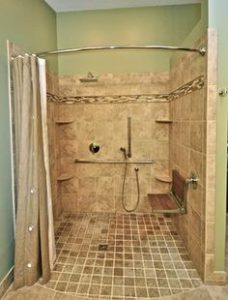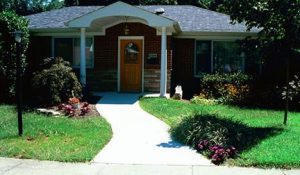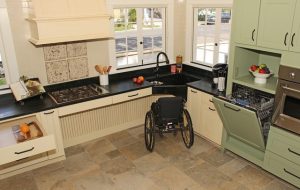By Scott Thomas
Almost exactly two years ago, we moved from a small inaccessible apartment into an accessible 1,200 square foot home we built. We were fortunate to have someone work with us to design the home. The accessible design aspect went smoothly, making the home smart is another story.
Let’s talk design first, then attempt to tackle the smart home dynamic in part two.
Living in the inaccessible apartment was challenging, but helped us to determine what areas we needed to focus on in our design. The first thing that we noticed was that we needed more space. Moving around in a bulky power chair is difficult in small spaces, especially when a caretaker needs to fit too.
The first area we focused on was the bathroom. The bathroom was our most important and most difficult design challenge. I assumed I could just Google accessible bathrooms and I would be done. Boy was I wrong. It turns out that definitions of accessible vary greatly, which now makes sense. There are a multitude of disability types, and what works for me might not work for someone else. With this in mind we skipped a Google design, and instead came up with one of our own.
We chose a box design with his and her sinks on adjacent walls. My sink is without drawers, allowing me to roll my walker right under the sink. The toilet is in an open corner with ample room to navigate the power chair. For most, choosing a toilet with a high-standing seat is important. The toilet is equipped with a remote controlled bidet, a must have in an accessible home. The shower stands on the same wall as my sink. There is no lip to the entrance of the shower, it looks great and is nice not to have a tripping hazard, but the bathroom gets flooded after each shower. It’s not perfect, but was the best route for us.

*An example of an accessible shower.
Sticking with the theme of space, we made sure I had extra room on my side of the bed, went with extra wide doors, and measured everything ahead of time to make sure my chair could easily fit everywhere.
Fortunately for us, my brother owns a landscape and concrete company. He worked with our builders to ensure the inside floor of the home was built level with the outside concrete. No need for any ramps, just smooth transitions from the inside to out.

*An example of an entrance with no step.
The home is centered around a large open room that includes our kitchen, living, and dining areas. Near the entry is a guest room/office and a bathroom, our room and bathroom is on the other side of the house. We think we got about as close as possible to designing the perfect accessible home for us.

*An example of an accessible open kitchen.
These are just a few points I felt were notable. There are almost limitless customizing options. Have questions about Scott’s accessible home? Ask Scott Thomas at scottthomas4110@gmail.com
Call MonTECH at 1-877-243-5511 to set up an assistive technology demonstration appointment, learn more about AT devices, or to ask questions about our services.
